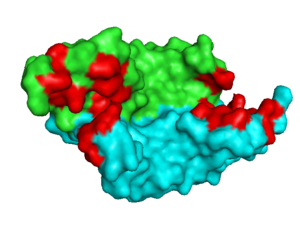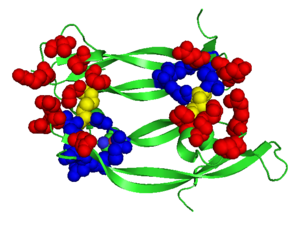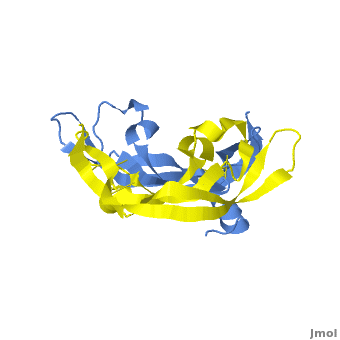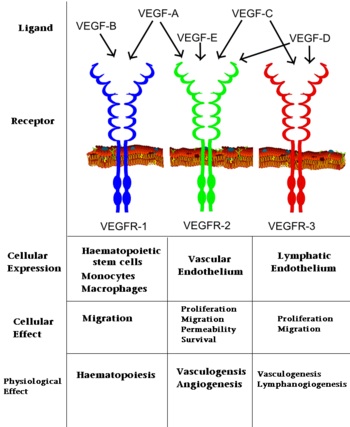Vascular Endothelial Growth Factor
From Proteopedia
 VEGF-A highlighting 2 monomers and binding sites in red, 1vpf
IntroductionVascular Endothelial Growth Factors (VEGFs) are a class of proteins that regulate vascular development in embryos and angiogenesis in adult mammals after sustaining an injury or notably in cancerous tumors. A number of structural studies have been conducted on VEGF and its receptors (VEGFRs) to better understand the VEGF-VEGFR interaction and how the signal cascade originating from this interaction leads to a number of biological features. VEGF and its receptors have been closely looked at for their potential use as targets for pharmaceutical medicine with some success. The VEGF family contains:
For additional information see: History and Biological FunctionVEGF-A was first described by Senger et al. in 1983 as a tumor secreted “vascular-permeability factor (VPF). [7] In 1989, Henzel and Ferrara reported the isolation of an endothelial cell mitogen they named VEGF which also mediated vascular permeability in vivo. Subsequent sequencing revealed that VPF and VEGF were identical, with the VEGF moniker sticking. [8]. VEGF represents a family of homodimeric glycoprotins which are essential for vasculogenesis (embryonic development of blood vessels), Lymphangiogenesis (lymphatic system development) and angiogenesis (formation of new blood vessels from pre-existing ones). [9] VEGF-A, arguably the most important member of the VEGF family, belongs to a gene family that includes placenta growth factor (PIGF) and VEGF’s B, C, D, E (Viral), and F (found in snake toxin) [10]. VEGF is produced by a range of cells including tumor cells, vascular smooth muscle cells, and macrophages. The VEGF-A gene contains a hypoxia responsive element, and hypoxia induces rapid production of VEGF-mRNA[11].The biological function of VEGFs is predicated upon binding to three receptor tyrosine kinases, VEGFR-1-3, that are typically localized on the surface of endothelial cells, bone marrow derived hematopoetic precursor cells, and some malignant cells. [12] VEGF identity determines which of the VEGFRs it binds with high affinity (See Image at the left). VEGF binding of a VEGFR begins a cascade reaction which ultimately leads to angiogenesis, vasculogenesis or haematopoiesis. The biological importance of VEGFs, especially VEGF-A, is highlighted by the fact that VEGF-A -/- knockout mice exhibit severe defects in vascular development and die at E9.5-10.5 [13]. Additionally, loss of just a single VEGF-A allele leads to vascular defects and death by E11-12 [14].
Structure of VEGF-A & its Biologyis a homodimer composed of two 23 kDa subunits. VEGF-A exists in a number of different isoforms following alternative splicing of its precursor mRNA [15]. In humans, 6 variants have been found: VEGF-A-121, VEGF-A-145, VEGF-A-165, VEGF-A-183, VEGF-A-189, and VEGF-A-206, with VEGF-A-165 the most abundantly expressed. All VEGF-A isoforms bind to VEGFR-1 and -2. The amino acids determined to be are D63, L66, and E67. VEGF-A binding by VEGFR-1 leads to cellular proliferation, migration, and increased cellular permeability resulting in vasculogenesis and angiogenesis. Those residues are I43, I46, Q79, I83, K84 and P85.[16] Binding of VEGF-A to VEGFR-2 results in similar Vasculogenesis and angiogenesis, but also lymphangiogenesis in embryos. The remainder of the is formed by D34, S50, E64, and F36. It is upon binding of VEGFR by VEGF that the subsequent signal cascade is initiated leading to angiogenesis, etc.[17]  Structure of VEGF-E. Red Highlights Binding sites, Blue Highlights the Cysteine Knot, Yellow Highlights the intermolecular Dislufide bonds, 2gnn Structure of VEGF-E as a ModelAlthough VEGF-E is only found in viral sources and thus is of less importance than VEGF-A, analysis of its structure is informative because it is the only member of the VEGF family that binds exclusively to VEGFR-2, the most essential VEGF receptor. Further, VEGF-E shares significant homology to VEGF-A, and thus can serve as an effective model. [18] consists of a homodimer that is covalently linked by two intermolecular disulfide bonds between . Each monomer contains a central antiparallel beta sheet, with the canonical found in other VEGFs. [19] The knot consists of an eight residue ring formed by the backbone of residues 57-61 and 102-104 and intramolecular disulfide bridges Cys57-Cys102 and Cys61-Cys104, and a third bridge, Cys26-Cys68, that passes perpendicularly through the ring. Each VEGF-E monomer contains an amino terminal alpha helix and three solvent accessible loop regions, L2, . are able to form a complex hydrogen bond network as well as extensive hydrophobic contacts with VEGFR making these loops ideal receptor specificity determinants. Residues: P34, S36, T43, P50, R46, D63, E64, and E67 make up the and are critical for binding to VEGFR-2 as determined by alanine mutagenesis.[20] Further, the salt bridge between is believed to be the source of VEGF-E’s VEGFR-2 specificity by preventing binding to VEGFR-1. [21] Medical ImplicationsVEGF has received significant attention from the pharmaceutical industry in the hopes of correcting impaired vessel function. Such impaired vessel function accompanies many pathologies including atherosclerosis, arthritis, some neurodegenerative diseases such as ALS, and malignant cell growth such as cancerous tumors. [22] In fact, numerous studies highlighted the increased expression of VEGF in cancer cells resulting in tumoral angiogenesis, providing the tumor with the network of blood vessels need to grow and expand. VEGF expression is stimulated by hypoxia, a common characteristic of most newly formed tumors, and genetic mutations such as K-ras and p53, extremely common mutations present in a majority of cancers. [23] Since angiogenesis in typical adults is infrequent while extremely common in tumors, VEGF serves as a selective therapeutic target for cancer. A number of drugs, like Bevacizumab (a monoclonal antibody better known as Avastin) have been developed to interrupt the VEGF-VEGFR connection, with some success. Avastin binds to and inhibits all VEGF-A isoforms and has achieved megablockbuster status by earning over $5 billion in 2009 for Roche. [24]
3D Structures of VEGFAdditional ResourcesFor additional information, see: References
| ||||||||||||
Proteopedia Page Contributors and Editors (what is this?)
Michal Harel, David Canner, Joel L. Sussman, Alexander Berchansky, Wayne Decatur, Jaime Prilusky



